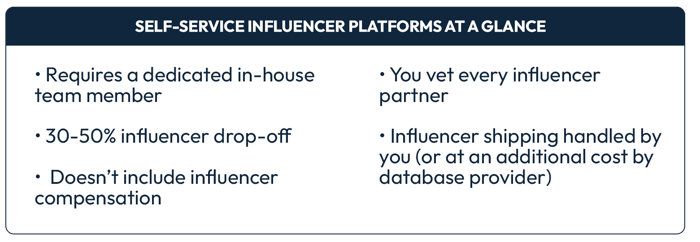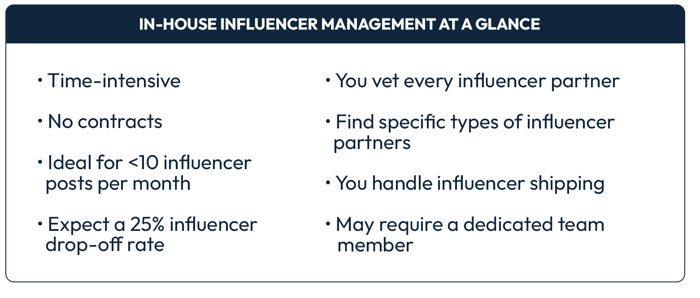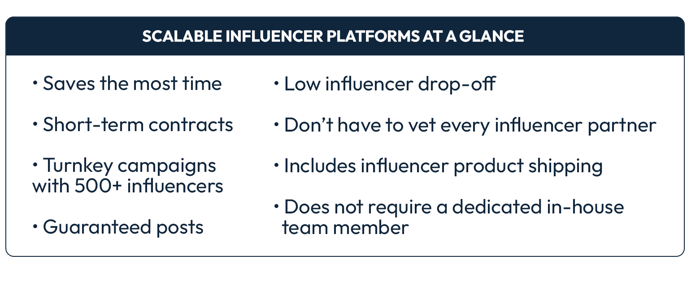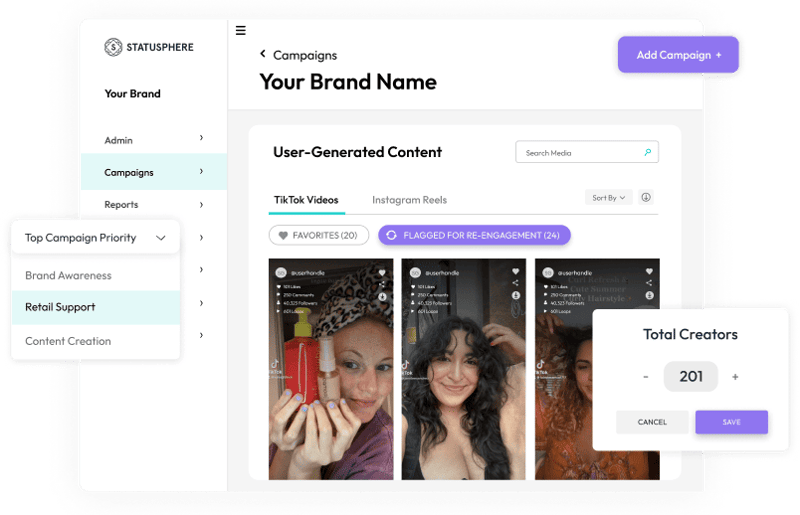Advertising CBD Products on Instagram: Why Product Gifting Is the Solution
The rules for advertising CBD products can be tricky to navigate without falling into legal grey areas that could get your brand in a lot of trouble....
Does your company really need an influencer marketing platform? Could you run in-house campaigns instead? This post breaks down the pros and cons of both!
.jpg)
.jpg?width=3000&name=diy%20vs%20platforms%20cover%20photo%20(1).jpg)
Trying to pick between influencer marketing platforms?
With 71% of marketers ready to increase their influencer budgets this year, you’re not alone.
But as more brands invest in influencers, the more they realize the legwork involved.
From managing outreach to shipping products and more, running a campaign is no small feat. That’s why brands are looking for influencer marketing tools to help with the heavy lifting.
If you’re not 100% sure which type of influencer platform makes sense for you, we’ve got you covered.
Below we break down the pros and cons of the various approaches to campaign management.
To kick things off, let’s quickly define what platforms and tools we’re talking about.
Influencer platforms refer to software and tools that help brands work with content creators. These platforms can streamline a variety of campaign tasks.
There are two distinct types of influencer marketing platforms:
Self-service platforms are tools that you or your team use to coordinate campaigns yourself. These tools include databases, CRMs and influencer marketplaces.
Scalable influencer platforms (like Statusphere!) programmatically match brands with creators and execute campaigns from start to finish. While we do the campaign-related legwork, our partners can monitor the progress and performance of campaigns through their brand portal without lifting a finger.
|
Self-Service Influencer Platforms |
Scalable Influencer Platform |
|
|
|
|
|
|
With the basics out of the way, let’s dig into the pros and cons of these platforms!
Self-service tools typically make it easier to organize your influencer outreach and campaigns.
But we refer to all of the above as “tools” because they don’t actually do the work for you.
| Pros | Cons |
|
|
|
|
|
|
|
|
Self-service databases and CRMs can definitely save you time. Having a list of influencers and a way to reach them beats starting a campaign from scratch, right?
But a database is just a database and a CRM is just a CRM.
A self-service platform gives you more control over your campaigns, sure. Yet consider how you’ll still need:
And even if you’re outsourcing all of the tasks above, you’re still paying for a platform.
If you want to get your money’s worth from a self-service tool, you have to be consistent and proactive about building relationships with influencers. You get out what you put in.
The catch? Content isn’t guaranteed when you use a self-service platform.
The more content you want, the bigger your investment of time and resources. This is especially true if you plan on scaling your content beyond just a handful of posts.
If you have the bandwidth for all of the above, great! If you’re not confident, you’re taking a risk. These platforms can put you in a “use it or lose it” situation where you’re locked into an annual contract.
Influencer marketing platform pricing and features vary wildly from company to company, too. Some platforms are just influencer directories. Others serve as a direct line of contact with creators. Make sure you read the fine print before you commit.
Another recurring challenge of these platforms is finding relevant influencers in niche industries. If a platform doesn’t feature the types of content creators you’re looking for, you’re stuck.
On that note, not every platform’s database of influencers is reviewed regularly. We’ve seen some platforms claim to feature over a million creators. Vetting that many social profiles by hand just isn’t possible. Inaccurate follower counts and engagement rates should be the least of your worries. Unfortunately, you have to keep these roadblocks in mind when using a self-service platform.

Self-service platforms aren’t the only way to run a campaign. For brands totally new to influencer marketing, a do-it-yourself approach is often the starting point.
This means no investing in third-party tools or hiring an influencer specialist. Instead, you rely on your existing marketing team and take advantage of free channels to manage and coordinate with influencers.
For example, a brand running a campaign this way might conduct outreach via Instagram or email to find creators to partner with. DIY campaigns are usually managed within an influencer spreadsheet rather than a CRM or traditional database.
As a startup ourselves, we totally get why you’d want to run campaigns in-house.
You want to stay lean and rightfully so! The DIY approach is obviously a more affordable influencer marketing option for budget-conscious brands. That said, let’s look at the pros and cons of running the show yourself.
| Pros | Cons |
|
|
|
|
|
|
Let’s say you’re willing to get your hands dirty and hire influencers yourself.
Like with platforms, you’ll still need a team member with the bandwidth to manage your campaign tasks. This includes vetting influencers, negotiating terms, handling communication and coordinating shipments.
Phew. If this sounds like a full-time job, that’s because it kind of is.
Although not really scalable, in-house campaigns are viable for brands that just want to source a handful of posts short-term through product gifting. We find that many brands that get started the DIY way soon realize they’re in for more than they bargained for.

Let’s say your company has outgrown the in-house approach and doesn’t have the time to allot to a self-service platform. There is a third option: a hands-off, scalable influencer platform.
These platforms (like Statusphere!) do the legwork of matchmaking, product shipping, and handling influencer relationships for you. In other words, your campaigns are managed and streamlined from start to finish.
| Pros | Cons |
|
|
Statusphere’s approach empowers influencers to post quickly, efficiently and on their own terms.
Given that micro-influencers like the ones in our network see higher engagement rates on Instagram and TikTok, you actually maximize your reach by working with smaller creators.
As an added bonus, your influencers are encouraged to create content they believe will perform best with their audience. Since they built their own following from scratch, they know what they’re doing.
If you’re willing to sacrifice a bit of creative control, the time and money saved can be huge with a scalable platform. For reference, we estimate 70+ hours saved per 30 influencer posts.
We take care of the most time-intensive and stressful aspects of any given campaign, too. This includes shipping products to creators and making sure they post.
And unlike other influencer platforms, content is guaranteed when you work with us!

We get it: choosing an influencer marketing platform is tough.
With so many moving pieces and ways to work with influencers, there are plenty of pros and cons to weigh.
If you want a hands-off approach with fewer question marks when it comes to the authenticity of influencers and their content, Statusphere's micro-influencer platform can help.
Our goal is to streamline and optimize our brands' influencer marketing strategies with guaranteed content at scale. Powered by advanced matchmaking and a vetted influencer network, our platform helps brands crush their marketing goals in a fraction of the time.

We've already generated 75,000+ pieces of authentic content for 400+ consumer brands.
Want to learn more about our platform? We’d love to walk you through it! Get in touch with one of our consumer-to-consumer marketing specialists today to learn how we get your brand content at scale.
This article was first published in January 2017. It was last updated September 12, 2022.
The rules for advertising CBD products can be tricky to navigate without falling into legal grey areas that could get your brand in a lot of trouble....
Product reviews help consumers trust your brand when they visit your website. Here are a few ways to drive online product reviews for your brand:
Gifting notes add a personal touch to your brand's influencer packages. Here's how to write your own influencer gifting note plus examples to inspire...
Be the first to know about the latest tools, trends and strategies in influencer marketing for brands.